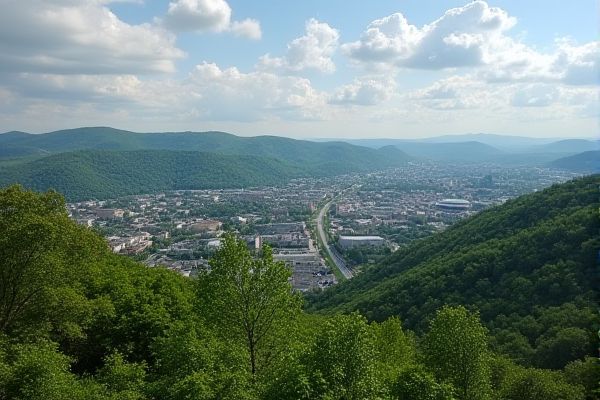
Transportation and commuting in Pennsylvania: Extensive public transportation networks available. SEPTA services Philadelphia and suburbs. Pittsburgh's Port Authority Transit options. Amtrak connects major cities statewide. Pennsylvania Turnpike toll road system. Carpool lanes in urban areas. Park-and-Ride facilities available statewide. Bicycle-friendly routes in major cities. Ride-sharing apps widely used. Seasonal weather affects travel conditions.
Extensive public transportation networks available.
Pennsylvania boasts an extensive public transportation network, investing over $1.6 billion annually. This comprehensive system includes 33 fixed-route systems, 42 community transportation systems, passenger rail services such as the Keystone Corridor and Pennsylvanian, alongside 10 intercity bus routes. Public transportation is accessible in every county, providing fixed-route transit, shared-ride services, and specialized options for seniors and persons with disabilities. For more detailed information, visit the Pennsylvania Department of Transportation website, which offers insights into the state's transportation offerings and initiatives.
SEPTA services Philadelphia and suburbs.
SEPTA (Southeastern Pennsylvania Transportation Authority) offers comprehensive transportation services, encompassing Regional Rail, buses, and metro lines, to serve Philadelphia and its surrounding suburbs. The Regional Rail system features 13 branches and over 150 stations, operating with a zone system to determine fares. For convenient travel, users can utilize the SEPTA Key card. More detailed information on their fare system can be found on the SEPTA website.
Pittsburgh's Port Authority Transit options.
Pittsburgh Regional Transit (PRT) offers extensive public transit options, including 98 bus routes, 3 light rail lines (the "T"), and 2 cable-powered inclines. The system includes a free-fare zone in Downtown Pittsburgh, real-time information through the TrueTime system, and convenient payment options via the ConnectCard and mobile apps like Ready2Ride and Transit.
Amtrak connects major cities statewide.
Amtrak connects major cities in Pennsylvania through several services, including the Pennsylvanian, which runs from New York City to Pittsburgh via Philadelphia, and the Keystone Service, which operates between New York City and Harrisburg via Philadelphia, with multiple stops at key cities such as Lancaster, Harrisburg, and Pittsburgh.
Pennsylvania Turnpike toll road system.
The Pennsylvania Turnpike is a 360-mile controlled-access toll road connecting Pittsburgh and Philadelphia, operated by the Pennsylvania Turnpike Commission. Utilizing an all-electronic tolling system, it offers convenient options such as E-ZPass or toll by plate for travelers. Along its impressive route, which features four tunnels through the Appalachian Mountains, there are 15 service plazas providing essential amenities for a comfortable journey. For those interested in the rich history and evolution of this pivotal roadway, you can explore more on the Pennsylvania Turnpike's official website. This infrastructure marvel stands as a testament to progressive transportation development in the state.
Carpool lanes in urban areas.
In Pennsylvania, Carpool Lanes, or High Occupancy Vehicle (HOV) lanes, are designed for vehicles with two or more passengers, including carpools and vanpools, and are typically open during rush hours to reduce traffic congestion and offer a faster commute. These lanes are not only a practical solution to road congestion but also promote environmental benefits by encouraging ridesharing. To learn more about how you can qualify for these lanes and take advantage of their benefits, visit the CommuteInfo website, where detailed information on eligibility and advantages of using these lanes are discussed. Embracing HOV lanes can significantly enhance the commuting experience by ensuring a quicker and more efficient travel time during peak hours.
Park-and-Ride facilities available statewide.
Park and Ride facilities in Pennsylvania, maintained by PennDOT, offer safe and convenient locations for commuters to leave their vehicles and use carpools, vanpools, or buses. These facilities are located near major highways and interchanges, providing easy access to public transportation and reducing congestion. For more detailed information on locations and services, you can explore the Park and Ride Map provided by PennDOT, which ensures that commuters have reliable options to streamline their journeys and contribute to less traffic on the roads.
Bicycle-friendly routes in major cities.
Philadelphia is making significant strides to enhance bike safety through the introduction of concrete-protected bike lanes on major corridors like Pine and Spruce streets. These plans include installing concrete curbs, planters, and enforcing stricter parking regulations to safeguard cyclists. The city boasts one of the highest bicycle commuting rates in the U.S., supported by robust infrastructure such as bike lanes, SEPTA bus bike racks, and rail transit bike policies, making it notably bike-friendly. Meanwhile, Harrisburg is advancing its Comprehensive Bicycle, Pedestrian, & Greenway Master Plan along with Vision Zero initiatives to further improve bicycle infrastructure, adding cycle tracks, and enhancing road safety for the cycling community.
Ride-sharing apps widely used.
At Penn State, the RideOn platform offers an exclusive service for faculty, staff, and students to simplify their daily commutes through efficient carpooling and planning one-time trips. This innovative tool not only encourages sustainable travel options but also helps track them, enhancing convenience and promoting environmental responsibility. Meanwhile, in southeastern Pennsylvania, the Share-A-Ride service provides a free and effective way to connect commuters to carpool, vanpool, and transit solutions. By offering valuable incentives, Share-A-Ride significantly reduces travel stress and environmental impact, further encouraging community members to participate in eco-friendly commuting practices.
Seasonal weather affects travel conditions.
Seasonal weather in Pennsylvania significantly affects travel conditions, with freezing temperatures and icy spots posing risks even on pre-treated roads. Speed and vehicle restrictions are often implemented during winter storms to ensure safety. Furthermore, heavy rain, snow, and extreme weather events can reduce road capacity, decrease average speeds, and increase travel time delays. For more information on how to stay safe during these conditions, visit the PennDOT Newsroom, where Officials on the matter provide updates and advice for commuters.
